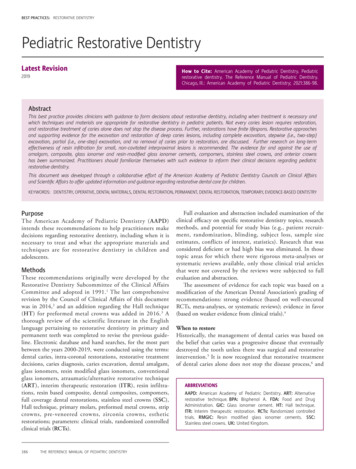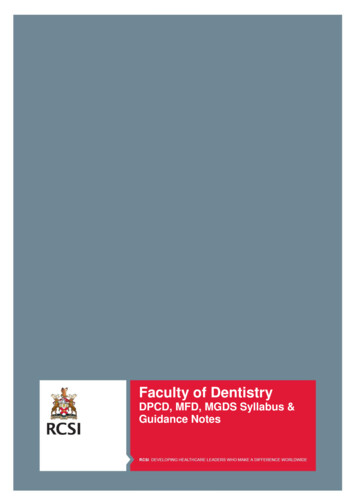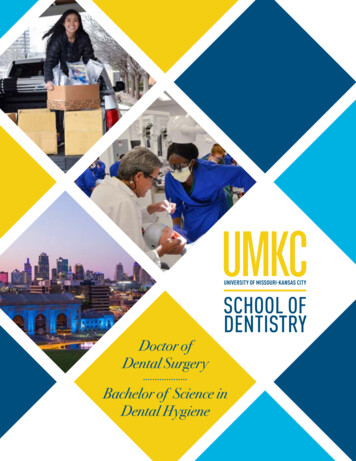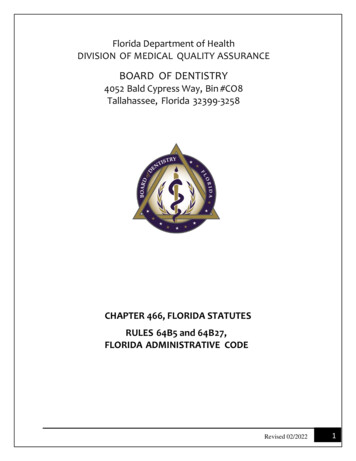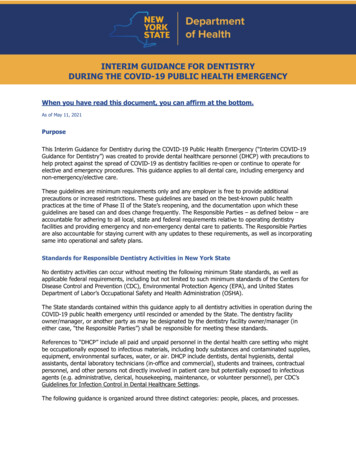
Transcription
INTERIM GUIDANCE FOR DENTISTRYDURING THE COVID-19 PUBLIC HEALTH EMERGENCYWhen you have read this document, you can affirm at the bottom.As of May 11, 2021PurposeThis Interim Guidance for Dentistry during the COVID-19 Public Health Emergency (“Interim COVID-19Guidance for Dentistry”) was created to provide dental healthcare personnel (DHCP) with precautions tohelp protect against the spread of COVID-19 as dentistry facilities re-open or continue to operate forelective and emergency procedures. This guidance applies to all dental care, including emergency andnon-emergency/elective care.These guidelines are minimum requirements only and any employer is free to provide additionalprecautions or increased restrictions. These guidelines are based on the best-known public healthpractices at the time of Phase II of the State’s reopening, and the documentation upon which theseguidelines are based can and does change frequently. The Responsible Parties – as defined below – areaccountable for adhering to all local, state and federal requirements relative to operating dentistryfacilities and providing emergency and non-emergency dental care to patients. The Responsible Partiesare also accountable for staying current with any updates to these requirements, as well as incorporatingsame into operational and safety plans.Standards for Responsible Dentistry Activities in New York StateNo dentistry activities can occur without meeting the following minimum State standards, as well asapplicable federal requirements, including but not limited to such minimum standards of the Centers forDisease Control and Prevention (CDC), Environmental Protection Agency (EPA), and United StatesDepartment of Labor’s Occupational Safety and Health Administration (OSHA).The State standards contained within this guidance apply to all dentistry activities in operation during theCOVID-19 public health emergency until rescinded or amended by the State. The dentistry facilityowner/manager, or another party as may be designated by the dentistry facility owner/manager (ineither case, “the Responsible Parties”) shall be responsible for meeting these standards.References to “DHCP” include all paid and unpaid personnel in the dental health care setting who mightbe occupationally exposed to infectious materials, including body substances and contaminated supplies,equipment, environmental surfaces, water, or air. DHCP include dentists, dental hygienists, dentalassistants, dental laboratory technicians (in-office and commercial), students and trainees, contractualpersonnel, and other persons not directly involved in patient care but potentially exposed to infectiousagents (e.g. administrative, clerical, housekeeping, maintenance, or volunteer personnel), per CDC’sGuidelines for Infection Control in Dental Healthcare Settings.The following guidance is organized around three distinct categories: people, places, and processes.
I. PEOPLEA. Physical Distancing Responsible Parties must ensure that a distance of at least six feet is maintained among patients,accompanying visitors, and staff at all times, unless safety of the core activity requires a shorterdistance (e.g. provision of care during dental visits and procedures); and Responsible Parties must ensure that patients and accompanying visitors wear face coverings at alltimes when in the dental facility, except when undergoing dental procedure. oAcceptable face coverings for COVID-19 include but are not limited to cloth-based face coveringsand disposable masks that cover both the mouth and nose.oFor more information protective equipment requirements for staff, See Section II “People,”Subsection B “Protective Equipment.”Responsible Parties must modify or restrict access to any waiting area seating, as needed, to allowsix feet of distance in all directions (e.g. spacing chairs, instructing people to sit in alternating chairs).oResponsible Parties should remove any frequently touched objects that cannot be cleaned anddisinfected regularly (e.g. toys, magazines, pens).oResponsible Parties should encourage visitors to wait outside or in vehicles until their designatedappointment time.oWhen distancing is not feasible within seating areas, Responsible Parties may enact physicalbarriers (e.g. plastic shielding walls in areas where they would not affect air flow, heating,cooling, or ventilation). If used, physical barriers should be put in place in accordance with OSHA guidelines,especially in reception areas to limit contact between patients and staff. Physical barrier options may include: strip curtains, plexiglass or similar materials, or otherimpermeable dividers or partitions. Responsible Parties should take measures to prevent congregation in elevator waiting areas and limitdensity in elevators, such as enabling the use of stairs. Responsible Parties should put in place measures to reduce bi-directional foot traffic using tape orsigns with arrows in narrow aisles, hallways, or spaces, and post signage and distance markersdenoting spaces of six feet in all commonly used areas and any areas in which lines are commonlyformed or people may congregate (e.g. elevator entrances, escalators, lobbies, patient check-in,reception, health screening stations, etc.). Responsible Parties must post signs throughout the dental facility, consistent with DOH COVID-19signage. Responsible Parties can develop their own customized signage specific to their workplace orsetting, provided that such signage is consistent with the Department’s signage. Signage should beused to remind DHCP, patients, and visitors to:oCover their nose and mouth with a face-covering.oProperly store and, when necessary, discard personal protective equipment (PPE).oAdhere to physical distancing instructions.oReport symptoms of or exposure to COVID-19, and how they should do so.oFollow hand hygiene and cleaning and disinfection guidelines.2
oFollow appropriate respiratory hygiene and cough etiquette.B. Gatherings in Enclosed Spaces In order to reduce the proximity of individuals, Responsible Parties should advise patients to limitaccompanying visitors to dental appointments, to the extent possible. As mentioned above, Responsible Parties should attempt to limit the number of persons in waitingareas by considering asking patients and accompanying individuals to wait in personal vehicles oroutside the dentistry facility if appropriate, and by attempting to minimize overlapping appointmentsfor dental visits or procedures. Responsible Parties must limit in-person employee gatherings (e.g. staff meetings) to the greatestextent possible and use other methods such as video or teleconferencing whenever possible, per CDCguidance “Interim Guidance for Businesses and Employers to Plan and Respond to CoronavirusDisease 2019 (COVID-19)”. When videoconferencing or teleconferencing is not possible, ResponsibleParties should hold meetings in open, well-ventilated spaces and ensure that individuals maintain sixfeet of social distance between one another (e.g. if there are chairs, leave space between chairs,have individuals sit in alternating chairs). Responsible Parties should consider tele-dentistry options where appropriate for non-emergencyconsultations to potentially minimize in-office care according to the CDC guidelines and OSHArecommendations. Responsible Parties must put in place practices for adequate social distancing in small areas, such asrestrooms and breakrooms, with appropriate signage and systems (e.g. flagging when occupied) torestrict occupancy when social distancing cannot be maintained in such areas.C. Workplace Activity Responsible Parties must take measures to reduce interpersonal contact and congregation, throughmethods such as:olimiting in-person presence to only those staff who are necessary to be on site;oadjusting workplace hours;oreducing on-site workforce to accommodate social distancing guidelines;oshifting design (e.g. A/B teams, staggered arrival/departure times). Responsible Parties should consider limiting dental care to as few patients as can safely be treatedsimultaneously with appropriate distancing whenever possible. Responsible Parties must allow adequate time between dental procedures for DHCP to fully andappropriately clean rooms and equipment, replace soiled PPE, and perform appropriate hand hygieneas described below. Responsible Parties should practice the following workplace activities in accordance with CDC“Interim Infection Prevention and Control Guidance for Dental Settings During the COVID-19Response”oMake sure that all unused supplies and dental instruments are appropriately covered and stored(e.g. closets, drawers, cabinets).oSet up patient rooms so that only necessary sterile equipment is accessible. Any supplies orequipment that are exposed but not used should be considered contaminated.3
oAttempt to limit or avoid aerosol-generating procedures whenever possible (e.g. avoid dentalhandpieces, air/water syringe, ultrasonic scalers) and prioritize hand instruments and minimallyinvasive/atraumatic restorative techniques. If aerosol-generating procedures are necessary, takeprecautions to minimize exposure (e.g. four-handed dentistry, high evacuation suction, dentaldams, limited personnel for procedure support).oMaintain appropriate ventilation systems to provide adequate air movement from clean tocontaminated areas, refer to the CDC guidelines and OSHA recommendations for additionaldetails on HVAC setup and appropriate air filtration.D. Movement of Individuals Responsible Parties should limit on-site interactions (e.g. designate an egress for individuals leavingtheir shifts and a separate ingress for individuals starting their shifts) and movements (e.g.employees should remain near their workstations as often as possible). Responsible Parties should limit the number of entrances in order to (1) manage the flow of visitorsinto the building and (2) facilitate health screenings, as described below in Section III “Processes,”Subsection A “Screening and Testing,” while remaining in compliance with fire safety regulations. Develop a plan for people to maintain six feet of social distance while queuing inside or outside of thefacility for screening, as applicable.II. PLACESA. Protective Equipment As mentioned above, Responsible Parties must ensure that patients and visitors wear face coveringsat all times, except when undergoing dental procedure. Acceptable coverings include at minimumcloth face coverings or surgical masks that securely cover the nose and mouth.oResponsible Parties should advise patients and all accompanying individuals to wear appropriateface coverings. If patients arrive at dental facilities without appropriate face coverings, considerproviding face coverings if supplies are adequate or asking patient to reschedule and return withan appropriate face covering. Responsible Parties can turn visitors away if visitors are not wearing face coverings or refuseto wear provided face coverings, per Executive Order 202.34. Responsible Parties must ensure that DHCP wear appropriate PPE when providing care to patients inaccordance with appropriate OSHA standards, including surgical masks, eye protection, gloves, andprotective clothing when performing any dental procedures that do not generate aerosols. Foraerosol generating procedures, providers should wear a properly fit-tested, NIOSH-certified,disposable N95 or higher-rated respirator, eye protection (e.g. goggles, face shield) gloves, andgowns. Responsible Parties must establish policies for DHCP PPE removal and replacement before and afterseeing patients. Responsible Parties must ensure DHCP follow CDC recommendations for and areproperly trained in donning and doffing PPE. Responsible Parties must ensure that staff with duties unrelated to patient care such as clerical staffalso wear appropriate face coverings at all times.4
Responsible Parties must procure, fashion, or otherwise obtain acceptable face coverings and PPE,and provide such coverings to their employees while at work at no cost to the employee. Anadequate supply of face coverings, gloves, masks and other required PPE should be on hand in theevent an employee needs a replacement, or a patient is in need. Responsible Parties must ensure that DHCP follow detailed instructions per CDC guidance onsuggested sequences for donning and doffing PPE.oFace coverings must be cleaned or replaced after use and may not be shared. Please consult theCDC guidance for additional information regarding PPE instructions and best practices.oNote that cloth face coverings or disposable masks shall not be considered acceptable facecoverings for workplace activities that impose a higher degree of protection for face coveringrequirements. For example, if N95 respirators are required for specific aerosol-generating dentalprocedures, a cloth face mask would not suffice. Responsible Parties must adhere to OSHAstandards for such safety equipment.oResponsible Parties must allow DHCP to use their own acceptable face coverings but cannotrequire staff to supply their own face coverings. Further, this guidance shall not prevent stafffrom wearing their personally owned additional protective coverings (e.g. surgical masks, N95respirators, or face shields), or if the Responsible Parties otherwise requires staff to wear moreprotective PPE due to the nature of their work. Employers should comply with all applicable OSHAstandards. Responsible Parties should also remind patients to wear appropriate face coverings in shared spacesbefore entering/exiting the facility (e.g. lobby, corridors, elevators). Responsible Parties must put in place measures to limit contamination from high-touch areas, such asinstalling touchless appliances such as contactless payments, contactless soap/towel dispensers, andcontactless trash cans.B. Hygiene, Cleaning, and Disinfection Responsible Parties must ensure adherence to hygiene and cleaning and disinfection requirementsfollowing each patient visit or procedure as advised by the CDC and DOH, including “CDC Guidelinesfor Infection Control in Dental Health Care Settings”, “Guidance for Cleaning and Disinfection ofPublic and Private Facilities for COVID-19,” and the “STOP THE SPREAD” poster, as applicable. If youmust provide dental care for patients suspected or confirmed to have COVID -19, requirements forcleaning and disinfection after procedures are included in the CDC Guidance for DentalSettings. Responsible Parties must maintain logs that include the date, time, and scope of cleaningand disinfection. Responsible Parties must ensure that DHCP clean operatory while wearing at minimum gloves,surgical mask, and eye protection such as goggles or face shield.oResponsible Parties must provide and maintain hand hygiene stations on site, as follows: For handwashing: soap, running warm water, and disposable paper towels. For hand sanitizing: an alcohol-based hand sanitizer containing at least 60% alcohol for areaswhere handwashing facilities may not be available or practical.5
Make hand sanitizer available throughout common areas (e.g. lobbies). It should be placed inconvenient locations, such as at entrances, exits, waiting areas. Touch-free hand sanitizerdispensers should be installed where possible. Responsible Parties should place signage near hand sanitizer stations indicating that visibly soiledhands should be washed with soap and water; hand sanitizer is not effective on visibly soiled hands. Responsible Parties should place receptacles around the dental facility for disposal of soiled items,including PPE. Responsible Parties must provide appropriate cleaning and disinfection supplies for shared andfrequently touched surfaces and encourage staff to use these supplies, following manufacturers’instructions, before and after use of these surfaces, followed by hand hygiene. Responsible Parties must conduct regular cleaning and disinfection of the facility and more frequentcleaning and disinfection for high risk areas used by many individuals and for frequently touchedsurfaces. Cleaning and disinfection must be rigorous and ongoing and should occur at least aftereach shift, daily, or more frequently as needed. Please refer to DOH’s “Interim Guidance for Cleaningand Disinfection of Public and Private Facilities for COVID-19” for detailed instructions on how toclean and disinfect facilities.oResponsible Parties must ensure regular cleaning and disinfection of restrooms. Restroomsshould be cleaned and disinfected more often depending on frequency of use. Responsible Parties must ensure distancing rules are adhered to by using signage, occupiedmarkers, or other methods to reduce restroom capacity where feasible.oResponsible Parties must ensure that equipment and tools are regularly cleaned and disinfectedusing hospital grade disinfectant. Refer to the OSHA recommendations, and the Department ofEnvironmental Conservation (DEC) list of products registered in New York State and identified bythe EPA as effective against COVID-19.oResponsible Parties should follow routine cleaning and disinfection procedures in accordance withstandard practices for disinfection and sterilization of dental devices contaminated with SARSCoV-2 as describes in the CDC Guideline for Disinfection and Sterilization in Healthcare Facilities,and the Guideline for Infection Control in Dental Health Care Settings.oResponsible Parties must provide for the cleaning and disinfection of exposed areas in the eventan individual is confirmed to have COVID-19, with such cleaning and disinfection to include, at aminimum, all heavy transit areas and high-touch surfaces (e.g. elevators, waiting areas,entrances, badge scanners, restrooms handrails, door handles).CDC guidelines on “Cleaning and Disinfecting Your Facility” if someone is suspected or confirmed tohave COVID-19 are as follows:oClose off areas used by the person suspected or confirmed to have COVID-19. Affected areas need to be closed off and cleaned and disinfected. Shared building spaces used by the individual must also be shut down, cleaned anddisinfected (e.g. elevators, waiting areas, restrooms). Responsible Parties must immediately communicate information about individuals suspectedor confirmed to have COVID-19 to all impacted entities occupying space in the building andinform them of which spaces are shut down and once they are re-opened.oOpen outside doors and windows to increase air circulation in the area.oWait 24 hours before you clean and disinfect. If 24 hours is not feasible, wait as long as possible.6
oClean and disinfect all areas used by the person suspected or confirmed to have COVID-19, suchas offices, bathrooms, common areas, and shared equipment.oOnce the area has been appropriately cleaned and disinfected, it can be re-opened for use.o Employees and visitors without close or proximate contact with the person suspected orconfirmed to have COVID-19 can return to the work area immediately after cleaning anddisinfection. Refer to DOH’s “Interim Guidance for Public and Private Employees Returning to WorkFollowing COVID-19 Infection or Exposure“ for information on “close or proximate” contacts.If more than seven days have passed since the person who is suspected or confirmed to haveCOVID-19 visited or used the facility, additional cleaning and disinfection is not necessary, butroutine cleaning and disinfection should continue.Responsible Parties must prohibit shared food and beverages among employees (e.g. self-servemeals and beverages), encourage employees to bring lunch from home, and reserve adequate spacefor employees to observe social distancing while eating meals.C. Phased Reopening Responsible Parties are encouraged to phase-in reopening activities so as to allow for operationalissues to be resolved before production or work activities return to normal levels. Responsible Partiesshould consider limiting the number of staff, hours, and number of patient appointments availablewhen first reopening so as to provide operations with the ability to adjust to the changes.D. Communications Plan Responsible Parties must affirm that they have reviewed and understand the state-issued industryguidelines, and that they will implement them. Responsible Parties should develop a communications plan that includes applicable instructions,training, signage, and a consistent means to provide individuals with information. Responsible Partiesmay consider developing webpages, text and email groups, and social media. Responsible Parties should institute a training plan for all DHCP to educate staff on new practices andresponsibilities before re-opening or expanding operations Responsible Parties should encourage individuals to adhere to CDC and DOH guidance regarding theuse of PPE, specifically face coverings, when a social distance of six feet cannot be maintained,through verbal communication and signage. Responsible Parties should post signage inside and outside of the facility to remind individuals toadhere to proper hygiene, social distancing rules, appropriate use of PPE, and cleaning anddisinfection protocols.III. PROCESSESA. Screening and Testing Responsible Parties must implement mandatory health screening practices of DHCP, patients, andvisitors.7
oScreening practices may be performed remotely (e.g. by telephone or electronic survey), beforethe employee or patient reports to the facility, to the extent possible; or may be performed onsite.oScreening should be coordinated to prevent individuals from intermingling in close or proximatecontact with each other prior to completion of the screening.oAt a minimum, screening must be required for all DHCP, patients, and visitors and completedusing a questionnaire that determines whether the individual has:(a) knowingly been in close or proximate contact in the past 14 days with anyone who hastested positive for COVID-19 or who has or had symptoms of COVID-19;(b) tested positive for COVID-19 in the past 14 days; and/or(c) has experienced any symptoms of COVID-19 in the past 14 days. Refer to CDC guidance on “Symptoms of Coronavirus” for the most up to date information onsymptoms associated with COVID-19. Responsible Parties must require DHCP to immediately disclose if and when their responses to any ofthe aforementioned questions changes, such as if they begin to experience symptoms, includingduring or outside of work hours. In addition to the screening questionnaire, temperature checks may also be conducted per U.S. EqualEmployment Opportunity Commission or DOH guidelines. Responsible Parties are prohibited fromkeeping records of employee health data (e.g. the specific temperature data of an individual), but arepermitted to maintain records that confirm individuals were screened and the result of such screening(e.g. pass/fail, cleared/not cleared). Responsible Parties must ensure that any personnel performing screening activities, includingtemperature checks, are appropriately protected from exposure to potentially infectious individuals.Personnel performing screening activities should be trained by employer-identified individuals whoare familiar with CDC, DOH, and OSHA protocols. Screeners should be provided and use PPE, including at a minimum, a face mask. Dental treatment for an individual who screens positive for COVID-19 symptoms should be deferred ifpossible and patient is not in need of urgent dental care. If emergency dental care is necessary,conform to CDC’s Interim Infection Prevention and Control Recommendations or refer to a facilitythat has appropriate engineering controls in place to take care of the patient. A DHCP who screens positive for COVID-19 symptoms must not be allowed to enter the worksite andmust be sent home with instructions to contact their healthcare provider for assessment and testing. oResponsible Parties should provide such individuals with information on healthcare and testingresources.oResponsible Parties must immediately notify the state and local health department about the caseif test results are positive for COVID-19.Responsible Parties must immediately notify the state and local health department of any positivecases. Responsible Parties should provide the individual with information on healthcare and testingresources.8
Responsible Parties should refer to DOH’s “Interim Guidance for Public and Private EmployeesReturning to Work Following COVID-19 Infection or Exposure” regarding protocols and policies forDHCP seeking to return to work after a suspected or confirmed case of COVID-19 or after the DHCPhad close or proximate contact with a person with COVID-19. Responsible Parties must designate a central point of contact, which may vary by activity, location,shift or day, responsible for receiving and attesting to having reviewed all questionnaires, with suchcontact also identified as the party for individuals to inform if they later are experiencing COVID-19related symptoms, as noted on the questionnaire. Responsible Parties must designate a site safety monitor whose responsibilities include continuouscompliance with all aspects of the site safety plan. To the extent possible, Responsible Parties should maintain a daily log of all DHCPs and visitors whomay have had close or proximate contact with other individuals in the in the facility; excludingdeliveries that are performed with appropriate PPE or through contactless means. Logs shouldcontain contact information, such that all contacts may be identified, traced, and notified in the eventan individual is diagnosed with COVID-19. Responsible Parties shall encourage but not require patientand visitor information as part of this log. Responsible Parties must cooperate with state and localhealth department contact tracing efforts. Responsible Parties must designate a central point of contact, which may vary by activity, location,shift or day, responsible for receiving and attesting to having reviewed all questionnaires, with suchcontact also identified as the party for individuals to inform if they later are experiencing COVID-19related symptoms, as noted on the questionnaire.oIdentified point of contact for the facility should be prepared to receive notifications fromindividuals of positive cases and initiate the respective cleaning and disinfection procedures.B. Tracing and Tracking Responsible Parties must notify the state and local health department immediately upon beinginformed of any positive COVID-19 test result by an DHCP at their facility. Responsible Parties mustbe prepared to receive reports of positive cases from DHCP, patients, or visitors, and notify asfollows. In the case of a DHCP, patient, or visitor testing positive, the Responsible Parties must cooperatewith the state and local health department as required to trace all contacts in the workplace, and thestate and local health department where the facility is located must be notified of all individuals whoentered the site dating back 48 hours before the individual first experienced COVID-19 symptoms ortested positive, whichever is earlier. Confidentiality must be maintained as required by federal andstate law and regulations. State and local health departments may, under their legal authority, implement monitoring andmovement restrictions of infected or exposed persons including home isolation or quarantine. Individuals who are alerted that they have come into close or proximate contact with a person withCOVID-19, and have been alerted via tracing, tracking or other mechanism, are required to selfreport to their employer at the time of alert and shall follow the protocol referenced above.9
IV. EMPLOYER PLANSResponsible Parties must conspicuously post completed safety plans on the premises of the workplace.The State has made available a business reopening safety plan template to guide business owners andoperators in developing plans to protect against the spread of COVID-19, and such plans are adaptablefor dentistry facilities to use.Additional safety information, guidelines, and resources are available at:New York State Department of Health Novel Coronavirus (COVID-19) Websitehttps://coronavirus.health.ny.gov/Centers for Disease Control and Prevention Coronavirus (COVID-19) ndex.htmlOccupational Safety and Health Administration COVID-19 onal Safety and Health Administration Recommendations for Dental Workers and try.htmlAmerican Dental Association: Return to Work – Interim Guidance Toolkithttps://success.ada.org/ /media/CPS/Files/Open%20Files/ADA Return to Work Toolkit.pdfAt the link below, affirm that you have read and understand your obligation tooperate in accordance with this ation10
Guidance for Dentistry") was created to provide dental healthcare personnel (DHCP) with precautions to help protect against the spread of COVID-19 as dentistry facilities re-open or continue to operate for elective and emergency procedures. This guidance applies to all dental care, including emergency and non-emergency/elective care.







